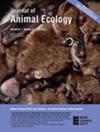栖息地结构和捕食者多样性共同决定了捕食者-猎物网络的排列。
摘要
研究重点:Chen, J, Wang, M. Q., Luo, A., Zhang, F., chester, D, Liu, S., Li, Y., von Oheimb, G., Kunz, M., Zhou, Q. S., Bruelheide, H., Liu, X., Ma, K., Schuldt, A., and Zhu, C. D.(2025)。在森林生物多样性实验中,自下而上和自上而下的效应结合起来驱动捕食者-猎物相互作用。动物生态学杂志。https://doi.org/10.1111/1365 - 2656.70103。栖息地结构影响捕食者-猎物和捕食者-捕食者的相互作用,并可能与捕食者多样性相互作用,从而决定食物网的动态。然而,只有有限的研究调查了栖息地结构和捕食者多样性如何共同塑造捕食者-猎物网络。Chen等人(2025)利用蜘蛛肠道内容物的分子分析,研究了树木多样性和蜘蛛系统发育多样性的各种措施如何塑造蜘蛛猎物网络。幼林冠层蜘蛛捕食网络具有丰富度、通用性、脆弱性和生态位重叠等特征。当将所有蜘蛛放在一起考虑时,树和蜘蛛的多样性都会导致猎物丰富度、猎物脆弱性和生态位重叠的增加,但普遍性是一致的。然而,当蜘蛛被分为两个觅食行会,织网者和捕猎者时,驱动食物网结构的因素在他们之间有所不同。尽管蜘蛛多样性和生境结构都影响蜘蛛捕食网络,但它们的相对重要性在两个行会之间存在差异。对蜘蛛而言,系统发育多样性是主要驱动力,高系统发育多样性导致猎物丰富度、通用性、脆弱性和生态位重叠增加。对于捕猎蜘蛛来说,树木的垂直多样性是形成网络结构的重要因素,垂直多样性的增加导致猎物丰富度和食物宽度的减少。总体而言,研究结果表明,树木多样性的自下而上效应和蜘蛛多样性的自上而下效应共同决定了蜘蛛捕食网络的结构。然而,树木多样性和蜘蛛系统发育多样性对蜘蛛捕食网络结构的影响是以树木多样性和蜘蛛觅食行会为条件的。研究结果对森林管理具有重要意义,林业工作者应致力于维持异质性森林,而不是简单的单一栽培,以增加蜘蛛对害虫的捕食压力,并确保生态系统的恢复能力。Research Highlight: Chen, J., Wang, M. Q., Luo, A., Zhang, F., Chesters, D., Liu, S., Li, Y., von Oheimb, G., Kunz, M., Zhou, Q. S., Bruelheide, H., Liu, X., Ma, K., Schuldt, A., & Zhu, C. D. (2025). Bottom-up and top-down effects combine to drive predator-prey interactions in a forest biodiversity experiment. Journal of Animal Ecology. https://doi.org/10.1111/1365-2656.70103. Habitat structure influences predator-prey and predator-predator interactions and may interact with predator diversity to determine food-web dynamics. However, only a limited number of studies have investigated how habitat structure and predator diversity jointly shape the predator-prey network. Using molecular analysis of spider gut content, Chen et al. (2025) investigated how various measures of tree diversity and spider phylogenetic diversity shaped the spider-prey network. The spider-prey network was characterized by prey richness, generality, vulnerability and niche overlap in young forest canopies. When considering all spiders together, both tree and spider diversity led to increased prey richness, prey vulnerability and niche overlap, but generality was consistent. However, when spiders were divided into two foraging guilds, web-builders and hunters, the factors driving the food-web structure varied between them. Although both spider diversity and habitat structure affected the spider-prey network, their relative importance differed between the two guilds. For web-builders, phylogenetic diversity was the main driver and high phylogenetic diversity of spiders led to an increase in prey richness, generality, prey vulnerability and niche overlap. For hunting spiders, the tree vertical diversity was an important factor shaping the network structure and higher vertical diversity led to a reduction in prey richness and diet breadth. Overall, the results show that the bottom-up effect of tree diversity and the top-down effect of spider diversity combined to jointly determine the structure of the spider-prey network. However, the impact of tree diversity and phylogenetic diversity of spiders on the structure of the spider-prey network was conditioned by a measure of tree diversity and spider foraging guilds. The results have important implications for forest management, and foresters should aim to maintain heterogeneous forests rather than simple monocultures to enhance predation pressure by spiders on pests and to ensure ecosystem resilience.

 求助内容:
求助内容: 应助结果提醒方式:
应助结果提醒方式:


